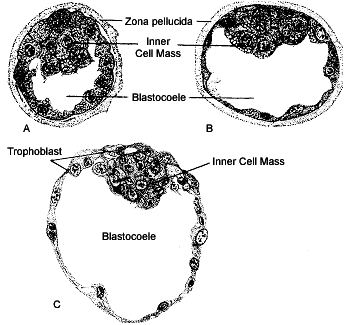Blastocyst Culture and Transfer in Delhi
What is Blastocyst?
 The blastocyst is a stage in the early development of mammals and humans. It consists of an outer layer of cells trophoectoderm and an inner cell mass. The outer layer contributes to the formation of placenta and the inner cell mass gives rise to the body of the embryo.
The blastocyst is a stage in the early development of mammals and humans. It consists of an outer layer of cells trophoectoderm and an inner cell mass. The outer layer contributes to the formation of placenta and the inner cell mass gives rise to the body of the embryo.
Normally the embryos formed in the laboratory are transferred to the uterus on day three, for implantation and further development. In some cases, the embryos have to be cultured up to day five-six.
What is Blastocyst culture?
Blastocyst culture is a technique developed for in vitro fertilization (IVF). This procedure intends to increase pregnancy rates while reducing the risk of multiple pregnancies by choosing the best embryo to transfer.


Advantages of Blastocyst Culture:
- This procedure ensures the quality of the embryos as only, good quality embryos survive to the blastocyst stage of development. This allows single embryo transfer if required.
- In an normal untreated cycle, the embryos reach the uterus on day six. So it is close to the normal stage of implantation and the uterus is physiologically ready to receive the embryo, so the success rates are good. This procedure is especially good for cases of repeated implantation failure.
- The procedure also helps to screen the embryos for genetic abnormalities. In such cases, the embryo biopsy is done on day two and the embryos allowed growing. The embryos are transferred on day five if they are normal. It ensures transfer of good quality embryos in IVF procedure.
Disadvantages of Blastocyst Culture:
- If the embryo number is less, it is possible that embryo growth may be arrested and no blastocyst forms. In such cases, there may be no embryos to transfer.
- There is a higher chance of identical twins due to splitting of the blastocyst.
For whom Blastocyst Culture and Transfer in Delhi is suggested?
The best fertility clinicsare nowoffering Blastocyst treatmentas regular means of improving the chances of pregnancy after a single embryo transfer. The procedure is useful for young women with multiple eggs, and has a good chance of success in IVF.
We suggest our patients to go for blastocyst culture if they had produced good quality embryos in their previous IVF cycle but had failed implantation due to different window of implantation.
This procedure is not recommended for someone who produces less than normal healthy eggs.
The success rate with blastocyst transfer is as good as in a natural conception as the embryo enters the uterine cavity at the same stage of development and implantation as normal.
Blastocyst culture is recommended in cases of previous IVF failures, and in cases of secondary infertility where the couple has one child and only desires one more child.

 Your Journey to Parenthood Begins with us!
Your Journey to Parenthood Begins with us!